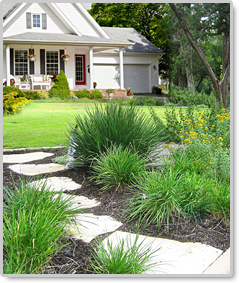Xeriscaping: A New Approach to Landscaping

In this article we will talk about the benefits of xeriscaping, the cost of xeriscaping, the limitations of xeriscaping and how to get around it, and rebate programs that make implementation of xeriscaping less expensive for you.
Water Conservation:
As you must be aware, water is increasingly becoming a limited resource. Research has shown that more than 50% of household water use goes toward landscaping. Over the year the water usage bill does add up considerably. Xeriscaping can use 70% less water if done correctly as it makes full use of the rainfall. This can be done by:
-
Using native plants species
-
Smart grouping of plants: the plants with similar water requirements to be grouped together
-
Use of some drought-resistant plants
-
Breaking up the landscape by putting in walkways and patios in the areas which get the heaviest foot traffic so that those areas save water (helpful accessory: rainwater collectors; drought-resistant plants).
Time Savings:
Xeriscaping leads to time savings as you need to spend significantly less amount of time mowing, weeding and fertilizing the lawn.
Increases property value:
For those of you who are looking to sell their property, xeriscaping considerably increases the property value due to its well-maintained look and lushness.
Environmental benefits:
For those of you who are looking to go green, what better way than xeriscaping. You will be doing your part in reducing pollutants in the air by eliminating the use of fertilizers and pesticides. You will also be creating awareness for the native plant species.
Energy Savings:
Studies have shown that xeriscaping cuts cooling cost by 46% due to its trees and shrubs as compared to the 4% of traditional lawns with no vegetation.
Cost and Savings of Xeriscaping
A xeriscaped lawn has an average payback period of 4 to 7 years. This is because of:
-
Elimination of fertilizers
-
Significantly low water usage bills
-
Significantly less maintenance required
Another savings which you should consider while xeriscaping is the volumetric savings in water. A 1,000 square foot lawn requires more than 132,000 liters of water each year. If you use native plants and drought-tolerant plants, you will require only around 55,000 liters of water a year. This is significant savings in your water bill and you still get a lawn that is well-maintained and colorful.One study which had looked into a standard Kentucky Bluegrass lawn with trees and shrubs found that it required 79 liters per square foot and the xeriscaped version of the yard only required 13 liters per square foot! Now that is savings.
Limitations of Xeriscaping and how to get around it
Like all trends, xeriscaping has its limitations:
-
Initially, it is labor intensive as you will have to prepare your lawn for xeriscaping
-
Choice of plants is limited
-
If you are new to the area you may not be familiar with the climate and native plant species
-
The initial cost of planting vegetation can be high
-
Budget constrictions may not allow you to do all that you want in xeriscaping
-
Periodic maintenance is required like pruning, deadheading.
Rebate programs for Xeriscaping
Many local governments provide rebate programs encouraging water-wise landscaping. Some rebates provide $500 for removing 500 square feet of grass. Through the U.S. Green Building Council, you can earn LEED (Leadership in Energy & Environmental Design) points which may also get you tax credits.
Related Articles . . .
Lawn Watering Tips: Better Results and Less Water
With community watering bans becoming more and more frequent, now is a great time to learn how to get the most benefit for your lawn while using the least amount of water.
Guide to Automatic Sprinklers
If you have an automatic sprinkler system for your lawn, this article and video will help you understand how your system works, how to winterize, and some operating tips for getting the most out of your system.
Lawn Mowing Tips for Nice Lawns & Personal Safety
Whether you do-it-yourself or hire a service, when done wrong, lawn mowing can damage your lawn, making it more susceptible to diseases. And if you do-it-yourself, lawn mowing also poses quite a few safety risks that you definitely want to avoid.
Spring Lawn Care Guide: the DO's and DON'Ts
Whether your approach to lawn care is do-it-yourself, or you are fortunate enough to have a service do the work for you, this article and video give you a quick list of springtime DO's and DON'Ts for taking proper care of your lawn.
Late Spring Lawn Care Guide
The needs of your lawn in late spring are very different than early spring. This article and video explain what, why, and how to fertilize during late spring for a healthy lawn.









